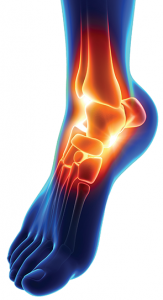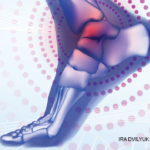
Four ankle prostheses are approved for use in the U.S. They do not require the bones to be fused.
Image Credit: decade3d – anatomy online/shutterstock.com
Ankle arthritis is a debilitating condition that leaves many patients in severe pain and greatly limits their activities. Until recently, the standard treatment for bone-on-bone ankle pain has been ankle fusion, or arthrodesis, in which surgeons literally fuse the bones of the ankle joint together. However, in the past few years, total ankle replacement surgery, also known as total ankle arthroplasty (TAA), has emerged as an alternate treatment for those with end-stage arthritis of the ankle.
History of Ankle Replacements
According to a Wall Street Journal article from November 2014, 26% of all ankle surgeries were replacements in 2010, up from 13% in 2007, and the global market for total replacement has grown 15% to 20% annually for the last several years, with 16,000 procedures completed in 2014.1
The first generation of devices used for ankle replacement in the mid-1970s yielded mixed results, but in the late 1990s, newer implants were developed that boast a higher success rate. Today, four ankle prostheses are approved for use in the U.S. These new designs don’t require the bones to be fused; instead, bone grows into the ankle prosthesis similar to hip and knee replacements.
Although fusions do alleviate pain in patients, the procedure also limits range of motion and mobility. In contrast, TAA is designed to mimic the natural movements of the ankle, allowing patients to safely resume light recreational activities and non-weight-bearing sports after surgery.
In addition, fusion also increases the chance of developing arthritis in adjacent bones due to ankle immobility, whereas TAA takes stress off the joints below and in front of the ankle, decreasing the risk of arthritis developing there.
Despite the growing popularity and benefits of TAA, many doctors and patients still aren’t aware that ankle joints can be successfully replaced.
Candidates
“Patients often tell us they didn’t realize TAA was an option for them,” says Dr. Shannon Rush, DPM, FACFAS, a Fellow of the American College of Foot and Ankle Surgeons and a surgeon at Palo Alto Medical Foundation in Mountain View, Calif. “I encourage rheumatologists who have patients that suffer from debilitating ankle pain to consider having them evaluated as candidates for TAA, especially before prescribing opioids.”
Dr. Rush says patients who don’t find relief through bracing or medications should be referred to a surgeon who is experienced in ankle replacement surgery for evaluation. Good candidates for TAA include those who have a joint that has been severely damaged by injury, osteoarthritis or rheumatoid arthritis. Patients who have had a prior ankle surgery, such as ankle fusion surgery, are also candidates for TAA.

